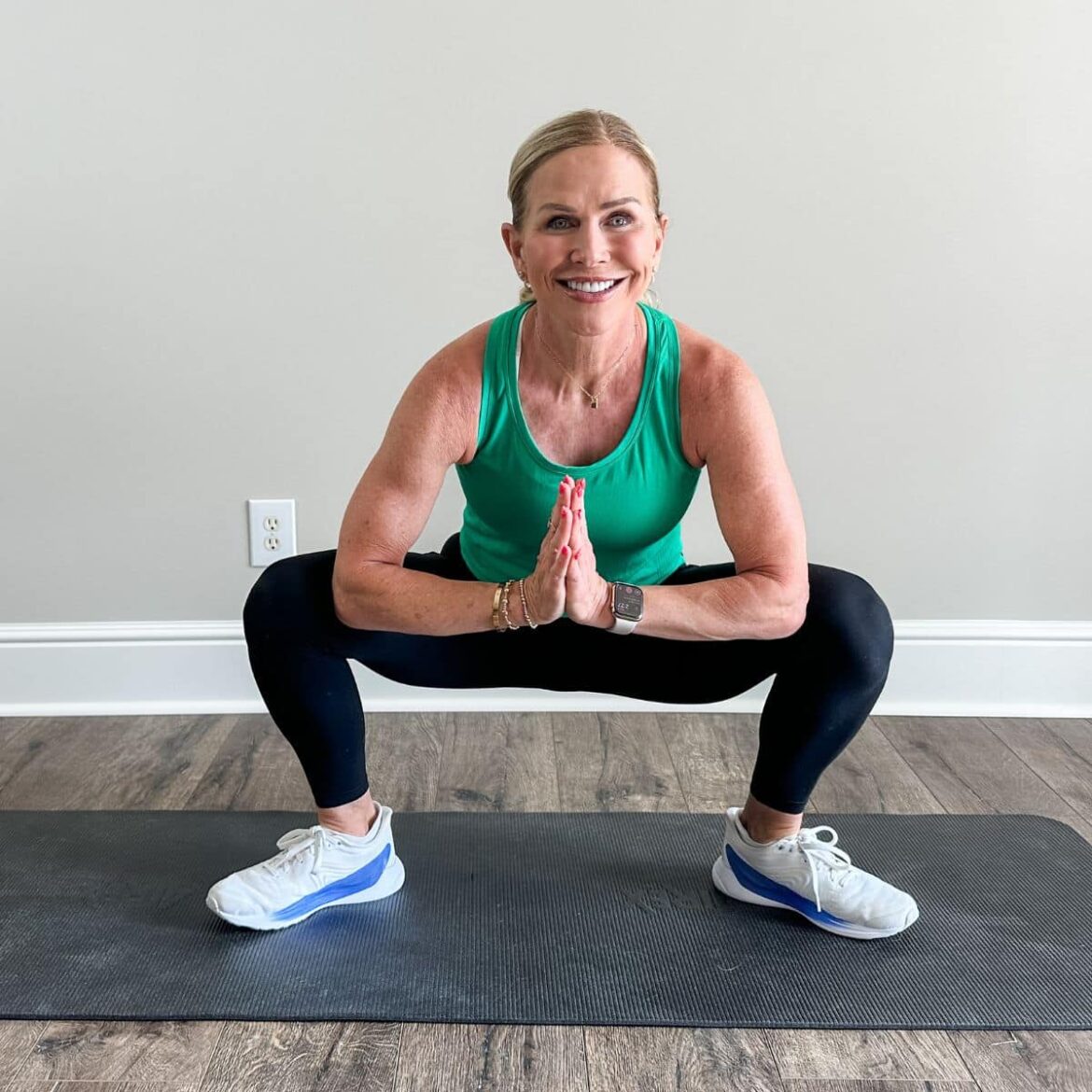Let’s talk about something that doesn’t always get the attention it deserves—hip mobility. Our hips are essential for almost every movement we make, from walking and bending to standing up with good posture. But as we age, they can tighten up, leading to stiffness, discomfort, and even a greater risk of falls.
The good news? You don’t have to accept stiff, achy hips as an inevitable part of getting older. One of the most effective ways to maintain hip flexibility and strength is by incorporating deep squat variations into your routine.
Now, I know what you might be thinking: “Deep squats? That sounds tough!” But don’t worry—I’m here to guide you through simple, approachable variations that can work for any fitness level.
Whether you’re aiming to improve balance, strengthen your pelvic floor, or just move more freely in daily life, adding deep squat variations—like the primal squat (also called the yogi squat)—to your workouts can be a game-changer.
From the view of a personal trainer and a woman who is turning 60 (yes – that is me!), this is why these movements matter and how you can start incorporating them today to keep your hips healthy.
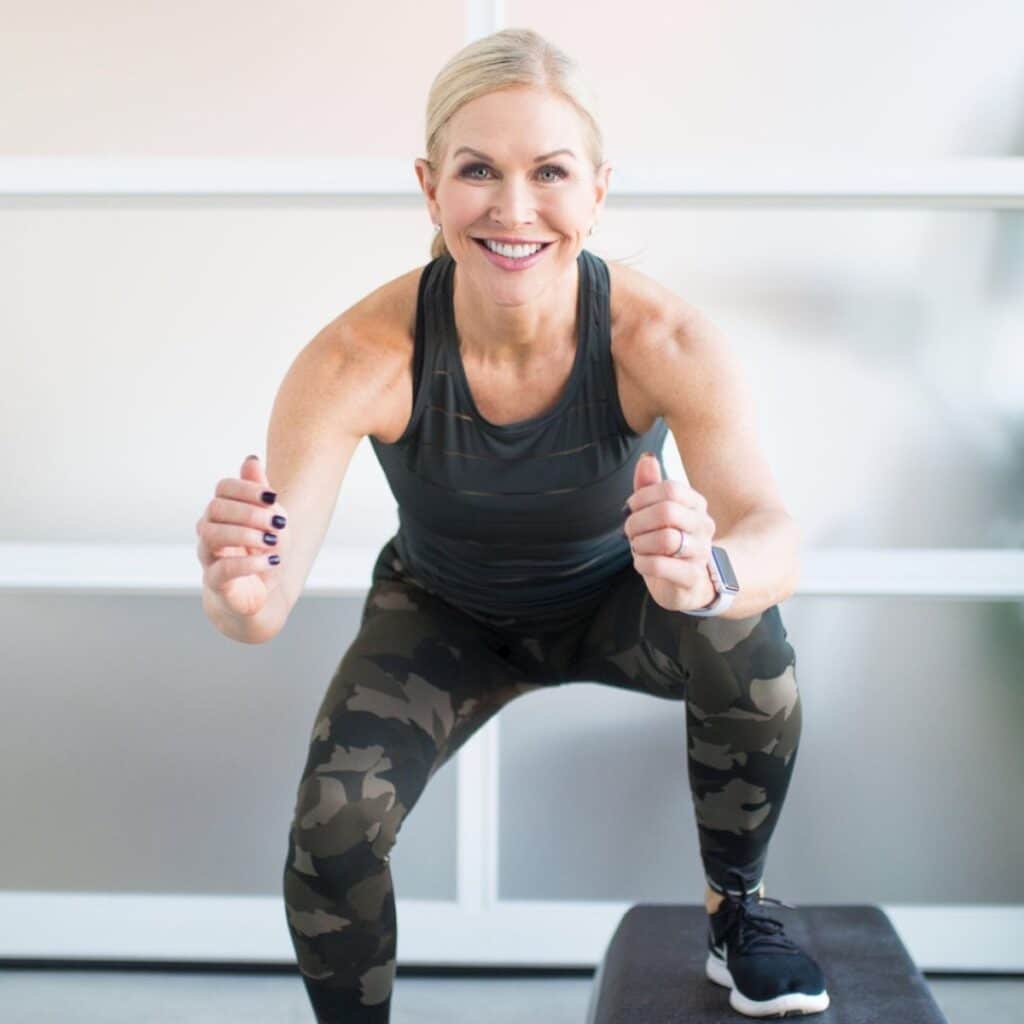

Why Deep Squat Variations Matter for Women Over 50
Staying mobile and active is more important than ever as we age. If you’ve noticed that simple movements—like squatting down to pick something up—feel harder than they used to, you’re not alone.
What’s interesting is that deep squats have been a natural part of daily life in many cultures for centuries. In parts of Asia, Africa, and among indigenous communities, people rest in deep squats for everything from cooking to socializing. It’s a posture that helps maintain mobility in the hips, knees, and ankles—joints that are crucial for maintaining independence as we get older.
Unfortunately, in modern Western cultures, we’ve traded squatting for sitting—and our bodies have adapted by becoming less mobile. Over time, that stiffness adds up, making basic movements harder and riskier.
Here’s a sobering truth: According to the CDC, falls are the leading cause of injury and death in older adults, and women are especially at risk. Around 75% of all hip fractures happen to women, and tragically, about 1 in 5 older adults who suffer a hip fracture die within a year due to complications like infections or loss of mobility.
But here’s the empowering part: deep squat variations can help prevent that kind of decline by building strength, improving balance, and keeping your joints functioning well.
It’s never too late to get started—and it’s one of the best gifts you can give your future self.
The Role of Hip Mobility in Aging
Your hips are involved in almost everything—getting out of a chair, walking up the stairs, playing with your grandkids, or just standing tall with good posture. When hip mobility declines, daily movements become harder and can even lead to balance issues or falls.
But here’s where deep squat variations come in. By practicing these movements regularly, you can keep your hips mobile, your muscles strong, your joints happy, and your body moving with ease.
How Deep Squats Help
Deep squats aren’t just about improving flexibility—they also:
- Strengthen the muscles around your hips
- Improve range of motion
- Engage your core, legs, and pelvic floor
- Promote better posture
When done correctly, deep squat variations—like the yogi squat—can help you move with more confidence. Whether you’re getting up from the floor, picking something up, or simply trying to feel less stiff throughout the day, these exercises are a must.
Common Concerns About Deep Squats
I hear a lot of hesitation from women when I mention deep squats so let’s address some common concerns:
“I have knee pain—can I still squat?”
Yes! Squatting itself isn’t the problem—poor form is. Modifications like a chair-assisted squat or wall-supported squat hold can help ease into deeper movements without pain. I always say in all my workouts, “no shame in the modify game.”
“I’m not flexible enough for deep squats.”
That’s exactly why you should start! Flexibility improves with practice. Small progressions lead to big gains.
“Aren’t deep squats bad for my joints?”
Actually, research shows that primal squats and yogi squats, when done with proper form, can strengthen your joints and improve function.
8 Deep Squat Variations for Improved Hip Mobility
All of these variations are bodyweight squats that you can do anywhere, anytime. Do a few of these daily to help improve mobility. Work up to doing all of them in a row.
1. Basic Yogi Squat (a.k.a. Primal Squat)
This is the foundational deep squat variation that promotes ankle, knee, and hip mobility. It’s also a natural resting position in many cultures. (It’s even more challenging barefoot.)
Exercise Instructions:
- Start with your feet slightly wider than hip-width apart, toes turned out just a bit.
- Lower your hips down toward the floor, keeping your heels grounded and your chest lifted.
- Bring your hands to heart center and press your elbows gently into your inner thighs to open your hips.
- Hold here, focusing on your breath and posture. Stay for 20–30 seconds or as long as feels good.


2. Yogi Squat with Hip Rocks
This variation adds gentle movement to help open the hips and loosen up tension through the pelvis and lower back.
Exercise Instructions:
- Set up in your basic yogi squat position.
- With your hands in prayer at your chest or resting lightly on your thighs, gently shift your weight from side to side.
- Rock slowly, pressing one knee out at a time and allowing the hips to sway side to side.
- Continue for 30–45 seconds, breathing deeply and keeping your chest upright.
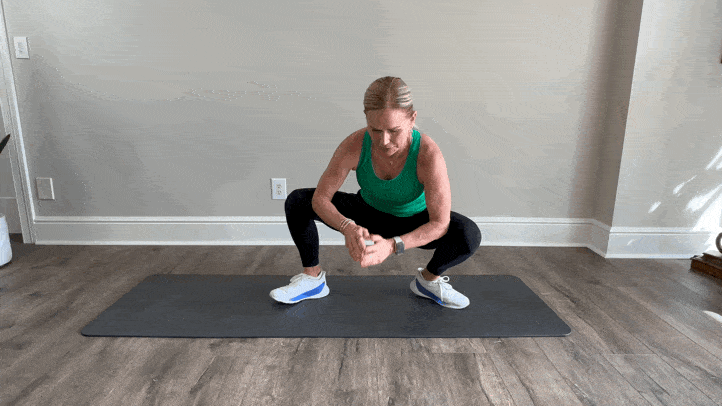

3. Deep Squat with Single Knee Taps
This movement builds strength and stability through your core and hips, while challenging balance and control.
Exercise Instructions:
- Lower into your deep yogi squat.
- Keeping your chest lifted and hips low, gently tap one knee to the ground (or just toward the ground if you can’t touch). Place your hands on the floor for balance if needed.
- Return to the center and switch sides.
- Alternate for 6–8 reps per side. Keep the movement slow and controlled—this one really works your legs and glutes!


4. Deep Squat with Arm Rotation and Reach
This adds a good upper body twist to your deep squat, helping to improve spinal mobility and posture.
Exercise Instructions:
- Begin in a deep squat with feet grounded and chest lifted.
- Place one hand on the ground in front of you and rotate your other arm up toward the ceiling, following it with your gaze.
- Feel the stretch through your upper back and chest.
- Return to center and switch sides.
- Perform 5–6 slow rotations on each side.
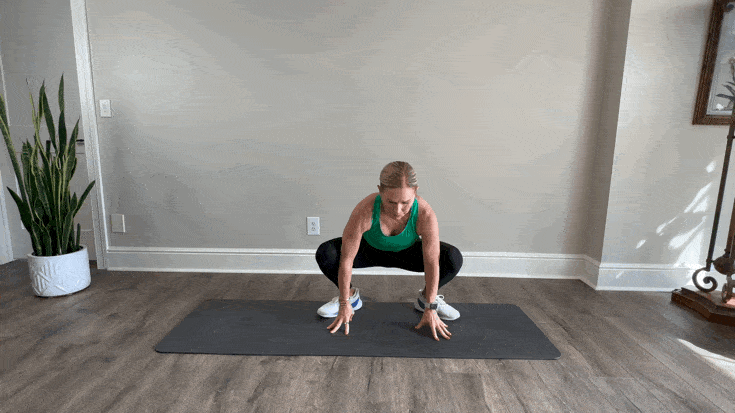

5. Deep Squat Walk-Out to Plank and Back
A dynamic full-body move that builds strength through the core, arms, and legs while reinforcing squat mechanics.
Exercise Instructions:
- Start in a deep squat with hands on the floor in front of you.
- Walk your hands out into a high plank position. Hold for a beat, engaging your core.
- Walk your hands back toward your feet and return to the deep squat position.
- Repeat for 5–8 reps, moving at your own pace.
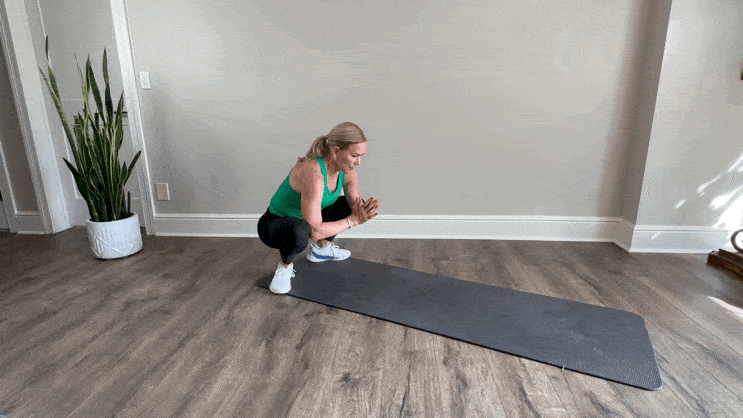

6. Deep Squat Reach to Stand
This one is great for training power and full-body mobility—perfect for building strength for everyday movements.
Exercise Instructions:
- Begin in your yogi squat.
- Reach both arms overhead as you press through your heels and rise to standing.
- Lower back down into the squat with control, bringing hands to heart center or back overhead.
- Perform 10–12 reps, keeping the movement fluid and breath-connected.
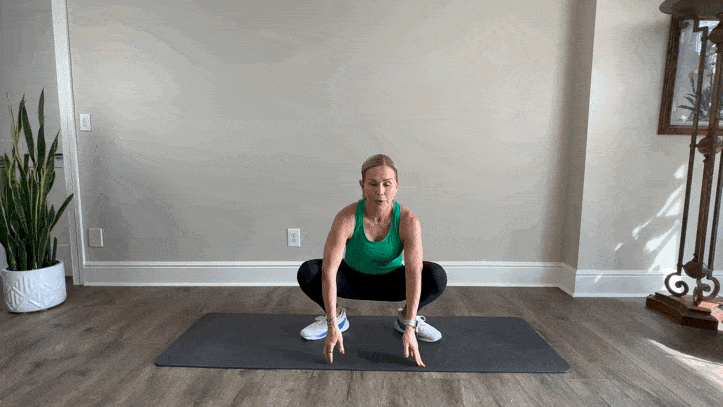

7. Cossack Squat
A fantastic side-to-side squat variation that targets the inner thighs, hamstrings, hips, and glutes while improving lateral stability.
Exercise Instructions:
- Stand with feet wide apart, toes slightly turned out and up.
- Shift your weight to one leg and bend that knee, lowering your hips while keeping the opposite leg straight.
- Keep your chest lifted and your heel grounded on the bending leg.
- Push back to center and repeat on the other side.
- Alternate for 6–8 reps per leg. Start shallow and work deeper as your mobility improves.
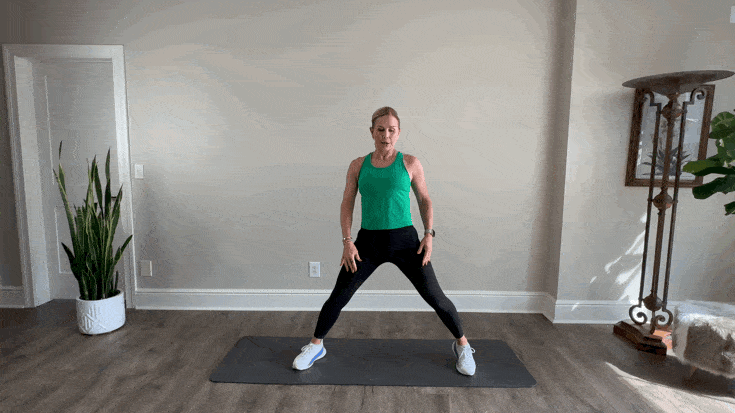

8. Chair-Assisted Deep Squat
This is a great beginner-friendly option or a gentle variation for anyone with balance issues or knee concerns.
Exercise Instructions:
- Stand in front of a sturdy chair or countertop for support.
- Place feet shoulder-width apart, toes slightly turned out.
- Lower into a squat, going as deep as feels comfortable while keeping your weight in your heels. Use the chair for balance, not to pull yourself down.
- Pause at the bottom, then press through your heels to return to standing.
- Repeat for 10–12 reps.
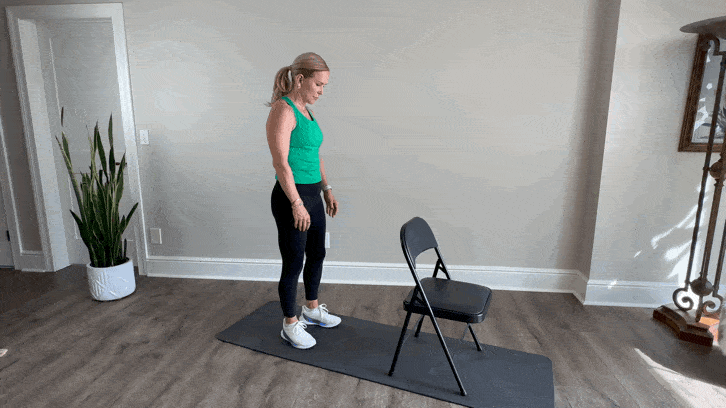

4 Key Benefits of Deep Squat Variations
Deep squats—especially variations like the primal squat or yogi squat—do so much more than just stretch your hips. They’re one of those “total body” moves that support strength, function, and longevity.
Here’s why they’re so beneficial:
1. Improves Bone Density and Reduces Osteoporosis Risk
Deep squats are a weight-bearing exercise, which means they put healthy stress on the bones—especially in your hips and legs. This stress signals your body to build and preserve bone tissue, helping to prevent the bone thinning that leads to osteoporosis.
For women over 50, this is huge—stronger bones mean fewer breaks, more stability, and better aging outcomes overall.
You may also enjoy my 10 osteoporosis exercises to strengthen your bones at any age!
2. Strengthens the Pelvic Floor and Core Muscles
As you lower into a squat, your core and pelvic floor muscles naturally engage to support your spine and stabilize your pelvis. And let’s be honest: we don’t always think about these muscles until something goes wrong—like leakage when you sneeze or laugh.
Deep squat variations help retrain and re-strengthen this entire area, which is key for bladder control, posture, and core integrity.
3. Enhances Balance, Coordination, and Joint Health
Because deep squats move through a full range of motion, they keep the ankles, knees, and hips mobile and well-lubricated. They also help you build neuromuscular control—which is a fancy way of saying your brain and muscles get better at working together.
This improves your overall balance and coordination, reducing your risk of falls as you age.
4. Reduces Joint Stiffness and Increases Circulation
Movement is medicine—and deep squats are no exception. By consistently practicing this movement, you increase blood flow to your lower body joints, which helps keep them lubricated and healthy.
That means less stiffness, more flexibility, and better recovery from everyday activities like walking, standing, or taking the stairs.
Safety Tips & Modifications
- Warm-Up First: Try leg swings, hip circles, or gentle squats before diving in.
- Listen to Your Body: Discomfort is okay; pain is NOT. If you feel pain, modify and/or reduce the range of motion at first.
- Progress at Your Own Pace: This goes with listening to your body. Start with supported squats and work your way deeper over time.
- Check with a Professional: If you have chronic joint issues, consult a physical therapist or doctor before beginning a new exercise routine.
Deep squat variations—including primal squats and yogi squats—are powerful tools for keeping your body strong, mobile, and pain-free as you age. The key? Consistency.
Start where you are, listen to your body, and celebrate progress—no matter how small. With time, you’ll notice a difference in how you move, feel, and even stand.
